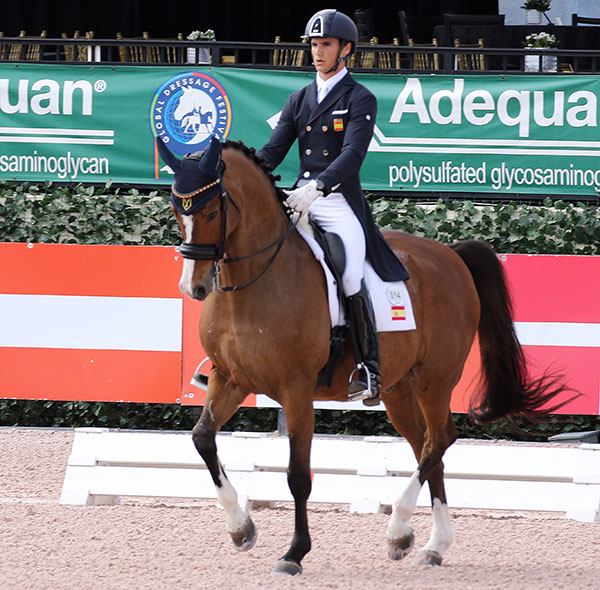Trainers Mostly Support Mandatory Freestyles for CDI Youth Events, But Upset at Another FEI Last-Minute Rule Enforcement
8 years ago StraightArrow Comments Off on Trainers Mostly Support Mandatory Freestyles for CDI Youth Events, But Upset at Another FEI Last-Minute Rule Enforcement

By KENNETH J. BRADDICK
WELLINGTON, Florida, Jan. 15, 2016–Trainers had mixed opinions but the majority supporting mandatory freestyles for most CDI youth competitions while several participants at the Adequan Global Dressage Festival expressed frustration at another last-minute enforcement action by the FEI, the International Equestrian Federation.
The opening Global World Cup event was the first CDI in the world subject to more stringent enforcement of FEI rules, although in place have not been applied at many competitions around the world, including some long established shows in Europe. Organizer of the seven Global CDIs at the Palm Beach International Equestrian learned of the requirements only weeks before the circuit opening when official schedules were returned by the FEI with changes.
Some trainers of youth riders who had transported horses to Florida from around the United States and Europe dropped plans to compete in the first Global event after learning of the freestyle requirement because riders had not prepared music or choreography. A World Cup event in Las Vegas that was the first dressage show in the world in 2017 canceled the freestyle for juniors although there was a rider in the individual class while only one of two riders in the individual young rider test advanced to the freestyle.
Junior, young and under-25 riders who typically compete in team, preliminary or Intermediate II classes and individual tests only have to perform a freestyles if they participate in the individual section, a requirement not previously enforced.
Trainers questioned in Wellington, starting its sixth year and has revolutionized dressage competition in the United States, were unaware of the freestyle requirement for youth divisions until this World Cup event that includes all dressage divisions.
Lendon Gray, an United States Olympian and organizer of the most extensive schedule of youth competitions and clinics around America as well as the iconic Dressage4Kids, said: “Why do the youth riders have to do it and not the senior riders because the youth riders are still learning and developing while the senior riders don’t do it? As someone who works with a lot of youth riders who are just getting into it, I would like to see these kids have the opportunity to do a CDI, get the experience in the big rings, go through all the rules and go through all of that. But many of them are not in a situation where they are ready to do a good quality freestyle. So what I’m afraid of is that either they are not going to do the CDIs because they have to have a freestyle or they’re just going to have some poor quality freestyle that they’re going to throw in.
“And if you have someone who lives in a far out place and they have only one CDI to go to in their life let’s let them get in there and have that experience and add the freestyles later.”

Oded Shimoni, an Israeli World Games rider who is based in Wellington and coaches youth riders, pointed out that in major senior championships three classes are required.
“Competition at this level is about three-day competitions. I think for a young rider it is good preparation, introduction and fitness for both the horse and rider at championships. If you are not in the habit of doing that for three days then when you come to do it as a young rider for three days you are shocked. As a senior rider you already went through young riders and you have more experience so it is not such a shock. I don’t think it’s a bad thing.”
Kimberly Herslow, an American team rider based in Stockton, New Jersey and Wellington, said: “I think it’s a good thing because it does prepare the riders if they want to be competing at CDIs or take the sport more seriously down the road. They’re going to be required to ride in three classes at both small tour and the Grand Prix at championships. It gets them exposed to learning how to do a freestyle, figure out the choreography, be a little creative. It gives them a taste at not such a high level how to manage the horses. Maybe they learn how to warm up more efficiently, figure out their plan and be more responsible. Most youth riders are eager to learn and need help managing it.”
Jacqueline Brooks, Canadian Olympian who winters in Wellington, said she believed that being able to ride a green horse in a Prix St. Georges, for example, without being compelled to ride the Intermediate freestyle but perhaps compete in national level Intermediate classes was a “good compromise.”
“If your horse is capable of doing an I-1 then I sort of agree with it,” she said. “It’s a show here. We’re here to show and showcase and promote our sport and the venue and when people buy tickets for three days of dressage entertainment and the I-1 is one of those classes then we should do it.
“For youth divisions, if you’re going to play the sport you might as well learn how to play. The Olympics are three tests, world championships are three tests, kürs are important, kürs are the future. So if you don’t practice kürs, you don’t learn how to ride and develop kürs by the time you get to Grand Prix you’re way behind the eight-ball. If you want to win an Olympic gold medal, as a junior learn how to ride a simple freestyle, then do a more complicated freestyle then you’re prepared when you get to Grand Prix. If the kids follow that, when we look at Friday nights (a Global highlight of CDI weeks) in four or five years when these kids are showing higher levels then our caliber will be way up.”

Nicholas Fyffe, an Australian trainer and competitor based in Wellington, said: “My initial reaction was that it was a big ask of the youth riders and their horses. But I feel it matters in developing riders to compete at an international level that they should be prepared.”
Juan Matute, a multi Olympian for Spain now based in Wellington, said: “It’s a good way for the kids to be fully inolved. But for horses new to the sport it is another hurdle. In many cases the youth riders are still learning the technical requirements and I feel that if the freestyles are mandatory they won’t be performed enthusiastically so they will be boring to the public. Moving to the Under-25 is already a big jump and requiring the freestyle makes it more difficult. We’re not prepared for the freestyles so we will not enter the next few shows until we’re ready with freestyles.”

The enforcement of some rules not previously followed and forcing a 20 per cent cut in the Global CDI4* prize money this year has occurred since dressage and para dressage were merged into a FEI department that also includes reining and vaulting. Jumping and eventing, the other two Olympic disciplines, remain separate departments.
The FEI pegs prize money only to equivalent values to Swiss francs and euros, neither of which are used in North America with no regard to previous prize money allocations in other currencies.

